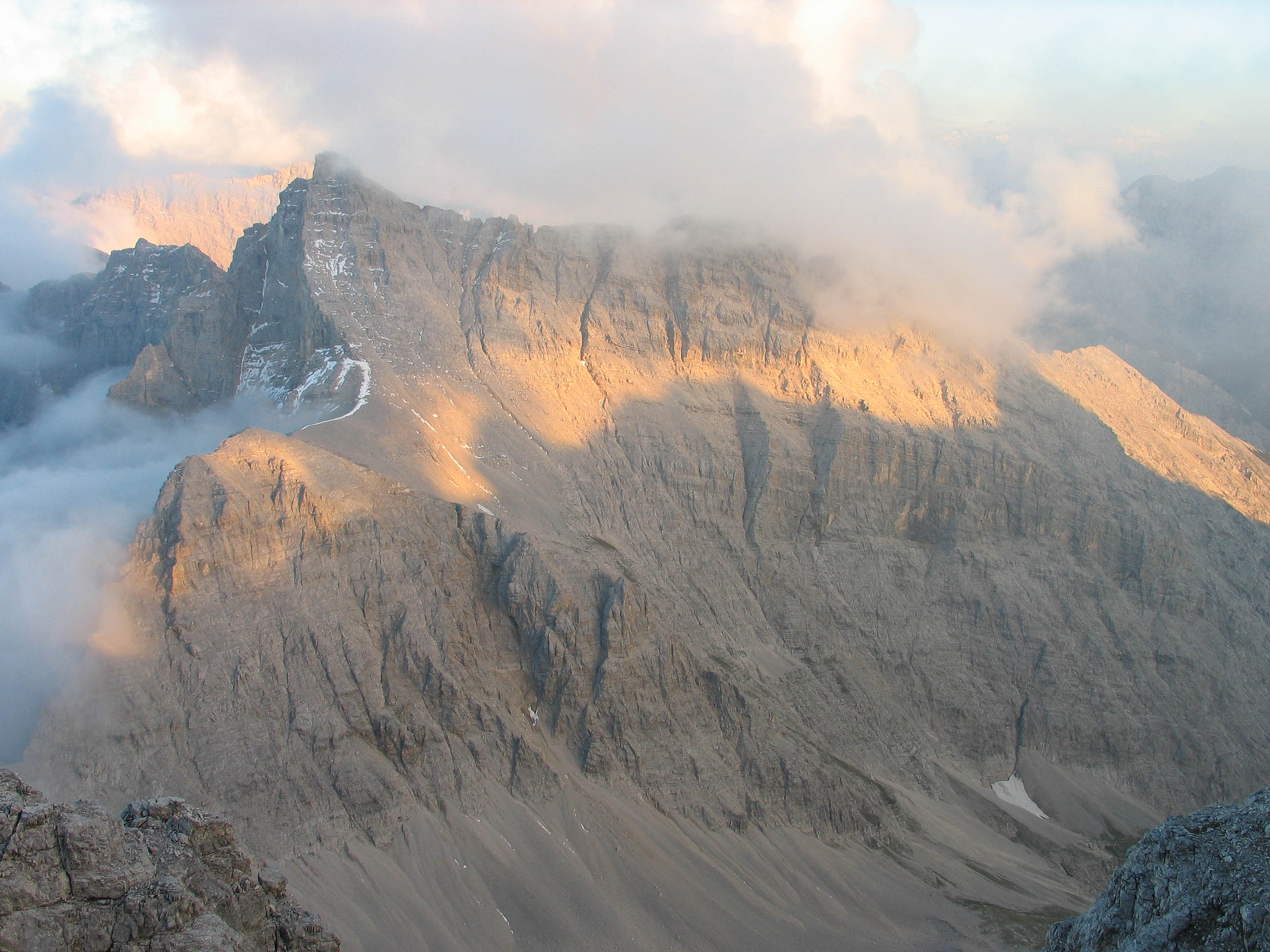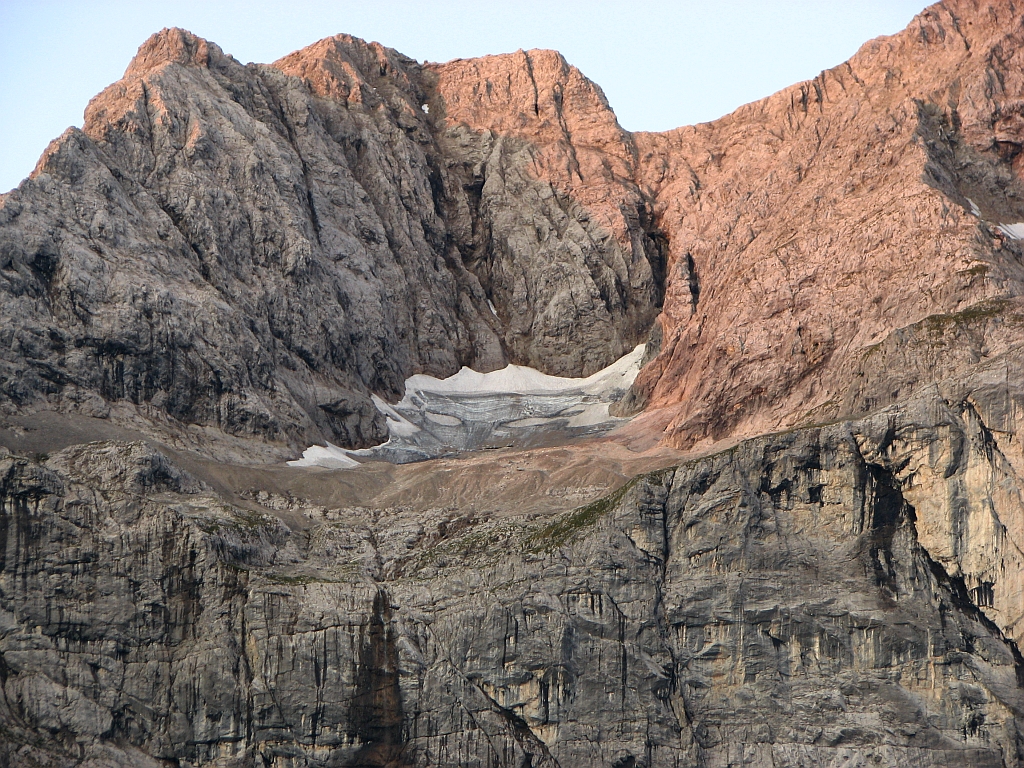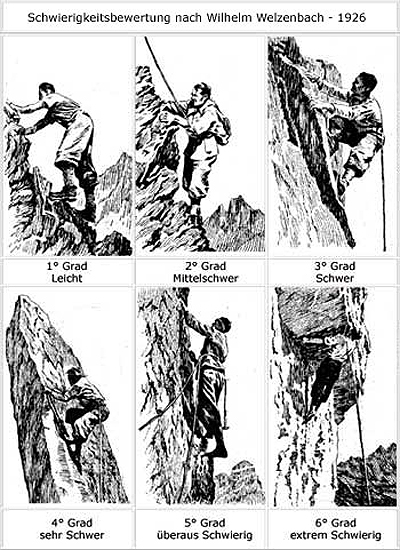|
Kaltwasserkarspitze
The Kaltwasserkarspitze is a mountain in the Hinterautal-Vomper Chain and, at m, is the fourth highest peak in the Karwendel mountains in Austria after the Birkkarspitze, Middle and Eastern Ödkarspitze. The Kaltwasserkarspitze is the eastern neighbour of the Birkkarspitze, its rugged summit dropping in a steep rock face to the valley of Kleiner Ahornboden. A long arête heads south from the mountain, on which are the ''Sägezähne'' ("saw teeth") and the Großer Heißenkopf () and which separates the ''Östliche Birkkar'' from the ''Raukarl''. The mountain was first climbed in 1870 by Hermann von Barth. Ascent The Kaltwasserkarspitze is not easy to reach. All routes involve sections of UIAA climbing grade II: * From the Hinterau valley The Hinterau valley (Rear Meadow Valley, German: ''Hinterautal'') is a valley crossing the Karwendel range from east to west. The Isar has its official source in the Hinterau valley. The valley stretches from its western end at Scharni ... [...More Info...] [...Related Items...] OR: [Wikipedia] [Google] [Baidu] |
Hinterautal-Vomper Chain
The Hinterautal-Vomper Chain (german: Hinterautal-Vomper-Kette), also called the main chain of the Karwendel (''Karwendelhauptkette''), is the longest mountain chain in the Karwendel Alps in Austria. It has numerous peaks that reach heights of 2,500 m, including the highest summit of the Karwendel, the Birkkarspitze (), and its neighbour, the three Ödkarspitzen. While long ridges radiate south and north from the western part of the main chain, with typical Karwendel cirques nestling between them, the eastern part of the chain has an almost 1,000 m high, solid rock face on the northern side, which is most striking at the Laliderer Wand. The main chain is divided into the Hinterautal ("Hinterau Valley") chain (''Hinterautalkette'') in the west and the Vomper Chain (''Vomperkette'') in the east and runs through the Karwendel Alps from Scharnitz in the west to the village of Vomp in the east. North of the Hinterautal-Vomper Chain is the Northern Karwendel Chain (''Nör ... [...More Info...] [...Related Items...] OR: [Wikipedia] [Google] [Baidu] |
Karwendel
The Karwendel is the largest mountain range of the Northern Limestone Alps. The major part belongs to the Austrian federal state of Tyrol, while the adjacent area in the north is part of Bavaria, Germany. Four chains stretch from west to east; in addition, there are a number of fringe ranges and an extensive promontory (''Vorkarwendel'') in the north. Geography The term Karwendel describes the part of the Alps between the Isar river and the Seefeld Saddle mountain pass in the west and Achen Lake in the east. In the north it stretches to the Bavarian Prealps. In the south the Lower Inn Valley with the city of Innsbruck separates the Karwendel from the Central Eastern Alps. Other major settlements include Seefeld in Tirol and Mittenwald in the west, as well as Eben am Achensee in the east. Neighbouring ranges are the Wetterstein and Mieming Mountains in the west and the Brandenberg Alps in the east. The mountaineer Hermann von Barth created the tradition of naming the Karwendel ch ... [...More Info...] [...Related Items...] OR: [Wikipedia] [Google] [Baidu] |
Hermann Von Barth
Hermann von Barth (5 June 1845 – 7 December 1876) was a famous German mountaineer. Life and career Hermann von Barth was born on 5 June 1845 at Eurasburg Castle. He initially studied law in Munich, where he was affiliated to the Corps Franconia. As a junior lawyer he began in 1868 in Berchtesgaden to explore the still largely unconquered Berchtesgaden Alps. From 1873 he studied natural sciences and, in 1876, deranged by fever, he committed suicide whilst on a research expedition in Africa. He died on 7 December 1876 in São Paulo de Loanda, Portuguese Angola. Von Barth is most well known for his exploration of the Karwendel mountains. In summer 1870 he climbed, alone, 88 peaks (12 for the first time, including the Birkkarspitze, Kaltwasserkarspitze, Lalidererspitze, Große Seekarspitze, Grubenkarspitze, Dreizinkenspitze, Eastern Karwendelspitze, Vogelkarspitze, Wörner, Kuhkopf). In 1871 he switched to the Wetterstein mountains and was the first to climb many ... [...More Info...] [...Related Items...] OR: [Wikipedia] [Google] [Baidu] |
UIAA
The International Climbing and Mountaineering Federation, commonly known by its French name Union Internationale des Associations d'Alpinisme (UIAA, lit. ''International Union of Alpine Clubs''), was founded in August 1932 in Chamonix, France when 20 mountaineering associations met for an alpine congress. Count Charles Egmond d’Arcis, from Switzerland, was chosen as the first president and it was decided by the founding members that the UIAA would be an international federation which would be in charge of the "study and solution of all problems regarding mountaineering". The UIAA Safety Label was created in 1960 and was internationally approved in 1965 and currently (2015) has a global presence on five continents with 86 member associations in 62 countries representing over 3 million people. After the 2022 Russian invasion of Ukraine, the UIAA suspended all UIAA officials from Russia, and delegates from the Russian Mountaineering Federation (RMF) and Russian officials and at ... [...More Info...] [...Related Items...] OR: [Wikipedia] [Google] [Baidu] |
Mountains Of The Alps
This page tabulates only the most prominent mountains of the Alps, selected for having a topographic prominence of ''at least'' , and all of them exceeding in height. Although the list contains 537 summits, some significant alpine mountains are necessarily excluded for failing to meet the stringent prominence criterion. The list of these most prominent mountains is continued down to 2500 m elevation at List of prominent mountains of the Alps (2500–2999 m) and down to 2000 m elevation on List of prominent mountains of the Alps (2000–2499 m). All such mountains are located in either France, Italy, Switzerland, Liechtenstein, Austria, Germany or Slovenia, even in some lower regions. Together, these three lists include all 44 ultra-prominent peaks of the Alps, with 19 ultras over 3000m on this page. For a definitive list of all 82 the highest peaks of the Alps, as identified by the International Climbing and Mountaineering Federation (UIAA), and often referred to as the ' ... [...More Info...] [...Related Items...] OR: [Wikipedia] [Google] [Baidu] |
Two-thousanders Of Austria
Two-thousanders are mountains that have a height of at least 2,000 metres above sea level, but less than 3,000 metres. The term is used in Alpine circles, especially in Europe (e.g. German: ''Zweitausender''). The two photographs show two typical two-thousanders in the Alps that illustrate different types of mountain. The Säuling (top) is a prominent, individual peak, whereas the Schneeberg (bottom) is an elongated limestone massif. In ranges like the Allgäu Alps, the Gesäuse or the Styrian-Lower Austrian Limestone Alps the mountain tour descriptions for mountaineers or hikers commonly include the two-thousanders, especially in areas where only a few summits exceed this level. Examples from these regions of the Eastern Alps are: * the striking Nebelhorn (2,224 m) near Oberstdorf or the Säuling (2,047 m) near Neuschwanstein, * the Admonter Reichenstein (2,251 m), Eisenerzer Reichenstein (2,165 m), Großer Pyhrgas (2,244 m) or Hochtor (2,3 ... [...More Info...] [...Related Items...] OR: [Wikipedia] [Google] [Baidu] |
Hinterau Valley
The Hinterau valley (Rear Meadow Valley, German: ''Hinterautal'') is a valley crossing the Karwendel range from east to west. The Isar has its official source in the Hinterau valley. The valley stretches from its western end at Scharnitz to its upper eastern end called Rossloch over 14 km from west to east. Starting from Scharnitz the mountain ranges of the Northern Karwendel range and the Hinterautal-Vomp chain limit the valley to the north, just interrupted by the Karwendel valley. To the south the Gleisch-Hall chain limits the valley. From the western side the valley first is deeply cut into by the waters of river Isar, after that part the valley follows more smoothly to the source of river Isar. After that the valley ends at an alpine bowl called Rossloch. Huts After the farms of ''Scharnizer Alm'' and ''Wiesenhof'' at the western part of the valley there are no more huts until the ''Kastenalm'' at the eastern part. From here only the ''Halleranger'' hut offers accommo ... [...More Info...] [...Related Items...] OR: [Wikipedia] [Google] [Baidu] |
Climbing Grade
In rock climbing, mountaineering, and other climbing disciplines, climbers give a grade to a climbing route or boulder problem, intended to describe concisely the difficulty and danger of climbing it. Different types of climbing (such as sport climbing, bouldering or ice climbing) each have their own grading systems, and many nationalities developed their own, distinctive grading systems. There are a number of factors that contribute to the difficulty of a climb, including the technical difficulty of the moves, the strength, stamina and level of commitment required, and the difficulty of protecting the climber. Different grading systems consider these factors in different ways, so no two grading systems have an exact one-to-one correspondence. Climbing grades are inherently subjective.Reynolds Sagar, Heather, 2007, ''Climbing your best: training to maximize your performance'', Stackpole Books, UK, 9. They may be the opinion of one or a few climbers, often the first ascensi ... [...More Info...] [...Related Items...] OR: [Wikipedia] [Google] [Baidu] |
First Climbed
In mountaineering, a first ascent (abbreviated to FA in guide books) is the first successful, documented attainment of the top of a mountain or the first to follow a particular climbing route. First mountain ascents are notable because they entail genuine exploration, with greater risks, challenges and recognition than climbing a route pioneered by others. The person who performs the first ascent is called the first ascensionist. In free climbing, a first ascent (or first free ascent, abbreviated FFA) of a climbing route is the first successful, documented climb of a route without using equipment such as anchors or ropes for aiding progression or resting. History The details of the first ascents of even many prominent mountains are scanty or unknown; sometimes the only evidence of prior summiting is a cairn, artifacts, or inscriptions at the top. Today, first ascents are generally carefully recorded and usually mentioned in guidebooks. The term is also used when referring ... [...More Info...] [...Related Items...] OR: [Wikipedia] [Google] [Baidu] |





_-_11.jpg)